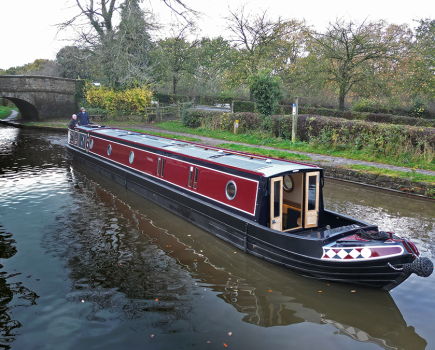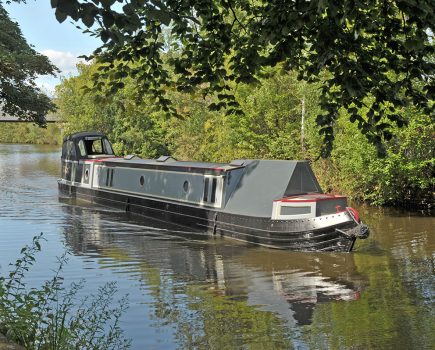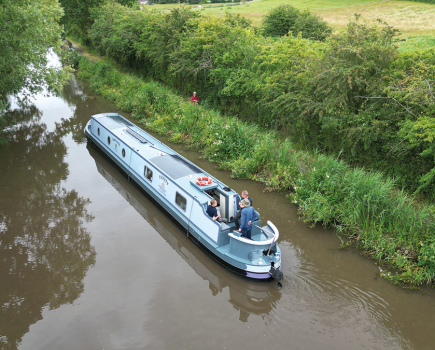A romantic refit means Delphine and David stay afloat on their old favourite; Winifred is a retired 1980s hire boat, refitted using reclaimed & recycled materials for a beautiful traditional narrowboat look

Reduce, reuse, recycle is the environmental mantra we’re all supposed to be trying to live by right now, to minimise our impact on the environment. But it can be difficult to see how to do that when it comes to new boats, which are by definition, new.
But here’s a boat whose owners were determined to reuse and recycle as much as possible to get their dream boat. So instead of having a new boat, Delphine Roche-Gordon and David Bryant refitted the one they already had – which was already a retired 1980s hire boat.
And they made sure that as much of the refit as possible made use of recycled and reclaimed materials. A master at the art of using reclaimed wood to make distinctive boat interiors is Jim Birch, so the couple took the boat to him to refit. They also had the original Lister engine rebuilt, and scoured the internet, junk shops and their own home for items to use.
Stripping out a boat and starting again gives the opportunity to replace systems such as the electrics, which had become unreliable or outdated, and the owners have done this. Having lived with the boat for a few years, they also had a list of things they wanted to change or add.

Exterior
If you’re going to spend a considerable amount of money on refitting a boat, it’s as well to make sure that the shell is sound. Sensibly, the owners had this boat surveyed – and the report said the steelwork was in fine condition, having lost very little thickness in spite of more than 30 years in the water.
But that is perhaps not surprising.
Winifred was built in 1986 by Les Allen, a well respected boat building firm based at Valencia Wharf in Oldbury. The company had begun building leisure boats in the 1960s, and carried on until the late 90s, when Les Allen’s sons retired. No one seems to know quite how many boats were built in total, but it must be into the hundreds. The firm developed quite a distinctive style of boat, and they have their enthusiasts even today. The bow is a particularly nice shape, but actually all the lines of the boat just look right.
Winifred was built for the Water Travel hire fleet, which was based at Autherley Junction, and was originally called Water Wanderer II. It was the last boat to be sold when the firm’s owner retired in 2008, which is when the current owners bought it. Can you imagine how many times it must have gone up and down the Shroppie or round the Four Counties Ring in more than 20 years of service?
Being a hire boat, there’s a large cruiser stern deck, with steps down into the boat set into it. This design (which was particularly popular in shorter boats – this one is just 48ft) does take a bit of getting used to, if you’re to avoid regularly falling down the steps. And you need to ensure your bilge pump is working, as you’ve got and external drop virtually down to the base plate, which will fill with rainwater if allowed.
At the bow, there’s a gas locker in the nose, and the well deck has storage lockers both sides. There’s also a flip-up table, making it a nice place to sit and eat when the weather allows. The water tank is underneath.
When the old interior was taken out, it emerged that insulation was minimal – just a thin sheet of polystyrene – which explained why the boat had been cold in winter. The shell was sprayfoamed, which the owners say has made a huge difference.
Delphine and David had the boat repainted in 2010 in an LNER livery from the 1920s, and it was done again as part of this refit, by Colin Dundas on the Grand Union. Green is the main colour, with black and cream coachlines, red handrails, and a raddle red roof. But perhaps the highlight is the gold lettering for the name and number.

Layout and fitout
This is a standard layout boat, with the saloon at the bow followed by the galley. Next comes a walk-through shower room, with the cabin at the stern. The layout of the boat is the same as before the refit. The fitout makes extensive use of reclaimed timber – the reason the couple went to Jim Birch. It uses a mix of oak, pine, and elm, from a variety of different sources (including a Royal palace). The owners also contributed some wood of their own, so some of the cupboard door fronts use panels they bought from online auction sites or junk shops.
Using reclaimed timber isn’t a cheap option though. It’s now increasingly sought after, and often arrives in a bit of state. It takes a lot of work to make it look good, including pressure washing, sanding, and waxing. It’s worth it, though, because the end result is a look which is soft and warm – and quite different from the feel of new wood.
The floor is particularly nice, made from oak laid in a keelson pattern – so there’s a central plank, with boards coming off at right angles.

Saloon
We’ll start in the saloon, where stable doors lead off the well deck. On one side is a Boatman stove, set in a hearth decorated with tiles found in a junk shop in Tenbury Wells.
On the other side is a cupboard with many functions. The upper door drops down to form a writing desk, while hidden inside is a small TV which pulls forward on an arm.
The door itself, made from a carved panel, was one of the owners’ discoveries. Either side of the doors are GWR lights, converted to take LED bulbs. Other lighting throughout the boat includes individually switched wall lights, and industrial style bulkhead lights on the ceiling. Throughout the boat, there are reproduction Bakelite switches, contributing to the vintage feel of the interior.
Furniture in the saloon includes a freestanding folding table, a small armchair (principally the domain of Mavis the Yorkie), and a sofa bed. This came from Elite Furnishings, which made some bespoke changes, so it would fit across the boat. The arm at one end has been slimmed down to just a board to reduce the width, and the back cushions have been shaped to fit under the gunwales.
One humorous feature is Philip the Mouse – made by a friend of the owners. He lives in a knothole in the wood in the cabin side.

Galley
A shelving unit filled with stuff divides the saloon and the galley. Set in the middle of the boat is a Heritage Uno range, which not only provides an oven and hot plate but also heats water and the radiators. It’s diesel fired. There is also a Thetford triangular three-burner gas hob as a secondary cooking method (the owners have a similar arrangement at home, with a range and an additional hob). But they thought the usual steel finish didn’t suit the boat, so they took it to a local car workshop and had it sprayed red to match the Uno.
There’s plenty more wood on show here, with oak worktops and cupboard doors made with more Ebay-sourced panels. A high level cupboard has a stained glass door, and a light inside to show it off. The glass came from a couple of panels the owners had bought many years ago, but had done nothing with. They were taken apart and refashioned into both the cupboard door, and panels for the doors between the galley and the shower room. On one side of those doors is a set of shelves, while on the other is a plate rack.
Another find is the substantial Belfast sink. Having hunted around for one, Delphine realised they had one in their garden at home, which had plants growing in it; it had been there when they bought the house. It’s now been returned to its original use.

Shower room
Of the must-have changes to the boat, several concerned the shower room. First, Delphine wanted a washing machine on board, given that the couple now spend several months at a time travelling. So the bottom half of a full-height cupboard houses a small Zanussi machine; the top half is an airing cupboard and linen store.
A better loo with a decent sized holding tank was also on the wish list, so there’s a SaniMarine macerating unit, with a pump out tank under the bed in the cabin beyond. It’s on the centre line of the boat so won’t affect the trim as it fills. However, a modern toilet didn’t really suit the look of the boat, so the lid and seat has been painted in traditional style, with roses on top and a castle inside. The artwork is by Christine Wood who’s based at Braunston. She normally paints water cans, stools, and other traditional items – but this loo seat looks so good, maybe there’s an opportunity to expand her range!
The third item which had to be changed was the shower itself. The previous fitout had a sort of hip bath arrangement with a moulded seat at one end, and a substantial lip to climb over. Now there is a proper walk-in shower with a good sized opening, and a shower curtain inside. The shower tray was made bespoke, and the tiles (which really suit the room) are off the shelf from a big retailer. Unusually, the shower has a window in it, and the cabinside wall ignores the shape of the gunwales, resulting in a much neater finish.
On the other side of the room is a unit with a floral basin, which was an online find, along with the tiles behind it. There’s a mirror above. The brass towel rail was covered in paint when David came across it, and it took a lot of work to restore. The lace curtains were found during a visit to Bruges in Belgium.

Cabin
Compared with the rest of the boat, the cabin is quite a straightforward space – although there are still flashes of recycled brilliance. One is the door from the shower room, which is made from elm and came from a stable; Jim Birch has just shaped it to fit the tumblehome.
The next is the headboard to the in-line bed: its two panels are actually the sawn off backs of chairs. The high level cupboards above the head of the bed have padding underneath, just in case you sit up without thinking. The bed base houses the loo tank, but there’s room for some drawers too; the far side houses the calorifier.
At the foot of the bed is a cupboard which contains all the electrics. A full height wardrobe, accessed from the corridor, provides storage space.

Technical
Winifred still has the original engine, although as part of the fitout it was completely rebuilt. It’s a Lister ST2, which is a twin cylinder air cooled model. Delphine says that as part of the rebuild it was at one stage nothing more than a wheelbarrow of bits – although David adds that it runs much better now than it did before.
The engine was moved back a couple of centimetres when it was re-installed, in order to give room in the engine bay for a generator. It’s a fairly compact 4kw unit by Fischer Panda – a model which was discontinued, so came at a good price. The addition of the generator means the batteries can be charged on a non-moving day without having to run the Lister; the generator is much, much quieter.
It was repeated failures of the electrics that played a large part in prompting the refit. So the boat has a completely new set up, including four 100Ah domestic batteries (plus one for the engine) and a 3kw Victron inverter charger. It’s a system which should be reliable, and with the generator never leave the owners short of power.

On the water
David warned me that the boat would be a pig to steer – but in fact it was fine. It’s a little deeper draughted than a more modern boat, and this is a factor on the often shallow South Oxford Canal where the couple are based. But it goes where it’s pointed, and we turned with no difficulty. The only thing to remember is that when switching from forward to reverse, the gearbox needs a second in neutral in between. The Morse control, which is often pretty low on cruiser-sterned boats, is at a decent height, as the column extends above the guard rail.
There’s no question that the Lister engine makes some noise, but the owners say it’s smoother now than before the rebuild, and some sound insulation has helped.

About the owners
Delphine Roche-Gordon and David Bryant met when they were both working on the set of the Catherine Cookson films, which were made in the north east of England in the 1990s. Delphine is a costume designer, and after many years working on BBC dramas, she went freelance. David was a focus puller, and has worked on many big productions including The Fifth Element and In The Name Of The Father.
David had been boating from when he was a child, and when the couple got together they bought a widebeam boat and lived in it on the Slough Arm of the Grand Union. When they moved back onto land, they still wanted to keep a connection to the waterways, so bought this boat.
Currently, they spend the whole of the summer on board. The refit of Winifred took so long (two and a half years, thanks to Jim Birch also having other projects on the go, and the pandemic kicking in) that they took the opportunity to hire a boat on the Broads, just to combat the water withdrawal symptoms.
Image(s) provided by:
ANDY R ANNABLE







